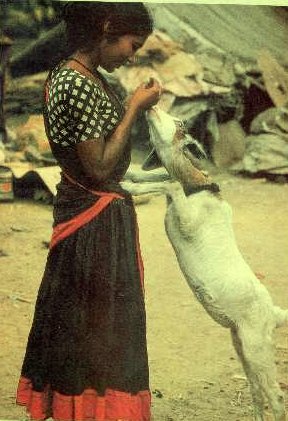
Home | Biodata | Biography | Photo Gallery | Publications | Tributes
[Back to Narikorava Studies]

 |
Home | Biodata | Biography | Photo Gallery | Publications | Tributes [Back to Narikorava Studies] |
 |
The Narikoravas use two kinds of snares. The first, called magiri, is used to catch cats and the second called kandhaaru is used for catching partridges. Both are made of strips of bamboo, strings of cotton, human hair and strips of jackal skin. Now-a-days they use nylon strings wherever possible.
1 THE CAT SNARE:
Magiri, the snare for cats is also called the modaavalai. It is made up of four nets on rectangular bamboo frames and a conical net made of circular frames. The snare is quite light and can be neatly folded flat and carried under the arm.
Each rectangular frame is made of split bamboo. Each frame is one muzham (cubit) high and one and a half muzham (cubit) long. (When measured, a frame was only 30 cms high (which is about 2/3 cubit) and 69 cms (about 1½ cubits) long). Each frame is covered with a net made of strips of jackal skin (nari vaar) which does not slip even if a strip breaks. The strips are laid parallel to each other in two directions connecting the vertical and the horizontal pieces of bamboo. At each junction the strips are knotted together and four knots form a rhombus. Each rhombus-shaped space is called a kan or eye. When measured, a rhombus had a diagonal of 3.2 cms in the horizontal direction and a length of 2.1 cms. A conical net is fitted with seven circular metal frames of about 45 cms diameter (which is about 1½ cubits). The total length of the conical net is nine cubits. Around each ring the net has 70 kan or spaces. The circular rings are kept about 60 cms apart.
In the field the rectangular nets are kept vertical, two on either side of the middle portion. At the middle portion there is a fifth rectangle formed by a horizontal piece of metal or bamboo, joining the tops of frames on either side. There is no bamboo strip or metal rod forming the lower portion of the central rectangle. The conical net is attached to the central rectangle. The rings of the conical net are kept vertical and the net is spread as a long horizontal cylinder which ends in a cone.
The animal is attracted to the net by a bait kept inside the net at the conical end of the net. A man sits close to the net and waits for an animal to enter the snare. Once an animal enters the snare the man closes the net and catches the animal alive.
2 THE PARTRIDGE SNARE:
Kandhaaru is a snare specially designed to catch birds such as partridges (kaudhari) using the slip noose. A smaller version of this snare is used to catch quails (kaadai).
The partridge snare is foldable into a narrow rectangular packet which is about 36 ankulas long and 8 ankulas high. A frame was found to measure 69 cms long and 16½ cms high. An ankula, or finger width varies from person to person.
The snare consists of 14 rectangular frames joined together by hinges with vertical bamboo axes. The two frames on either end are covered with horizontal strips of bamboo held in place by three vertical bamboo strips. These are used to guide the birds towards the middle of the snare.
Each of the remaining twelve frames is divided by vertical pieces into six parts called veedu or house, the rectangular frames are in two sizes. The top horizontal beam (called the female) fits under the top horizontal beam (called the male) of the next frame, in the hinge arrangement. The upper portion of the top beam (male) is decorated by small slits cut into the bamboo.
To the midpoint of the upper beam of each veedu is attached a slip-noose made of nylon string (which has perhaps replaced the traditional horse-hair). To make sure that partridges go straight to the slip noose, the rest of the veedu is so designed that the bird cannot easily avoid the noose, unless it flies over the snare. One long string (lower string) is used to weave through the lower part of all the veedus and another long string (upper string) is used to weave through the upper part of the veedus. This operation of making the snare is carried out by two men working together. The upper string connects the mid-point of every upper beam to the nearest vertical beam. The lower string connects the mid-point of every lower beam to the nearest vertical beam where it meets the upper string. Now-a-days a nylon string is used as the lower string instead of the traditional jackal skin strip. The jackal skin strip is believed to be stronger than the nylon string and the former does not slip should it get damaged or broken. The upper string is made out of cotton and human hair picked from dumps.
In the field when partridges are sighted, the birds are surrounded by the snare which may form a circle of about 5 metres diameter or a semicircle. When the birds try to escape they get caught in the snare. Some times the birds fly off and make good their escape. The methods of using the snares were demonstrated by the Narikorava inhabitants of Orakadu village.
|
|
| a) The Kandhaaru Net - Veedu
|
| b) The Kandhaaru Net - A rectangular frame
|
|
c) The Kandhaaru Net - The complete snare
|